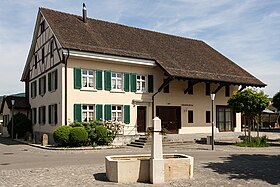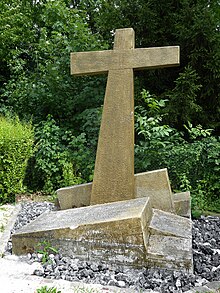Reinach BL
| BL is the abbreviation for the canton of Basel-Landschaft in Switzerland and is used to avoid confusion with other entries of the name Reinach . |
| Reinach | |
|---|---|
| State : |
|
| Canton : |
|
| District : | Arlesheim |
| BFS no. : | 2773 |
| Postal code : | 4153 |
| UN / LOCODE : | CH RCH |
| Coordinates : | 611 368 / 260 274 |
| Height : | 304 m above sea level M. |
| Height range : | 270–373 m above sea level M. |
| Area : | 6.97 km² |
| Residents: | 19,216 (December 31, 2018) |
| Population density : | 2757 inhabitants per km² |
| Website: | www.reinach-bl.ch |
|
Village center |
|
| Location of the municipality | |
Reinach ( Basel German : Riinaach ) is a municipality in the Arlesheim district in the canton of Basel-Landschaft in Switzerland . The second largest municipality in the canton of Basel-Landschaft after Allschwil is located at 303 m above sea level. M.
geography

Reinach is located at the southern foot of the Bruderholz in the Birstal and has a short border connection with the city of Basel. The eastern border of the community is formed by the Birs river with its dense floodplain forest and the Reinacher Heide . This is a bird paradise and has many botanical rarities. Neighboring communities are Arlesheim , Münchenstein , Bottmingen , Oberwil , Therwil , Aesch , and the city of Basel and Dornach in the canton of Solothurn . The area of the municipality is 700 hectares, of which 29% is agricultural area, 17% forest, 53% settlements and 1% unproductive area.
history
The oldest archaeological finds (graves and tools) go back to the Middle Stone Age . In the local area from 2002 to 2005 finds from about 7,000 to 800 BC were made. Made in BC, the Bronze Age (1800 - 800 BC) is a little more sparsely represented, but ceramics, a carpet of shards from the mouse field, graves and pieces of jewelery prove that Reinach was also settled during this time. Graves were also found from the Latène period (800-100 BC), and cremation graves , coins, tableware, glass vessels and much more from the Roman period (from 100 BC) . A strongly stylized and weathered grave stele from the Sundgau Molasse from the Hallstatt period was found in 1973 in Hubackerstrasse.
The first written tradition in which Reinach is mentioned as Rinacho comes from the reign of Ludwig Garewart , who was Bishop of Basel from 1164 to 1176 . In 1194 it was noted that Reinach belonged to the Beinwil monastery . A large part of the village was destroyed in the great Basel earthquake in 1356. In 1373 the diocese of Basel fell into debt and Reinach was pledged to Messrs Hannemann and Ulrich von Ramstein .
When Basel joined the Old Confederation in 1501 , Reinach remained part of the Basel diocese. The Reinachers had to go to church in Pfeffingen until 1511 and only then received their own parish with a village church. From 1525 Reinach was reformed, but returned to the old faith in 1595 under the Basel bishop Jakob Christoph Blarer von Wartensee . Reinach became the economic center, the seat of the administrative department and owned the fruit and salt store of the two bailiffs Birseck and Pfeffingen.
As a result of the French Revolution , the Bishop of Basel fled in 1792 and the Birseck was occupied by French troops. Under French rule, Reinach became the canton capital of the Mont-Terrible department for a short time . In 1800 the number of departments was reduced and the village was now ruled from the capital Colmar . It was not until the Congress of Vienna in 1815, which awarded the Birseck to the canton of Basel and the Swiss Confederation, that it was more closely linked to Switzerland.
During the Basel canton separation , the conflict between the city and the countryside, the Reinachers behaved loyally to the city, but in 1833 they became part of the new canton of Basel-Landschaft with the rest of Birseck.
With a little more than 1200 inhabitants, Reinach was still a pure farming village at the beginning of the 20th century. The large vineyard, which is almost completely built over today, was part of the townscape. Until the 1930s, today's central school grounds of the community with the Bachmatten, Lochacker and Weiermatt schools were a wide open corridor. As the name suggests, it was swampy and sometimes even covered with reeds, so that storks felt comfortable too.

The year 1907 saw the beginning of the clear population development in Reinach, when the community , which was located off the Jura Railway at the time, was first connected to the nearby Rhine city with the opening of the Basel – Aesch tramway . Reinach's residents were now offered the great advantages of the closer city with its opportunities to earn a living and the cultural offerings, on the other hand, rural tranquility and large building land reserves attracted more and more newcomers to the Birseck village. With the motorization, the change from a farming village to a commuter and agglomeration place accelerated even more. While the village had 3,475 inhabitants in 1950, the population quintupled in the following three decades to over 18,000.
coat of arms
- Split; in front in silver a red Baselstab (bishop's staff ), behind in blue three golden spheres placed in stakes
The three spheres are the attributes of the church patron St. Nicholas. With the colors silver and blue, the split shield emphasizes the membership in the Birseck episcopal office ; the red stick (without crabs) also reminds of the diocese of Basel.
population
29.6% of the population are Roman Catholic and 24.6% are Reformed. The proportion of foreigners is 22.3%. (As of June 2016)
economy
Reinach belongs to the economic area of Northwestern Switzerland and the agglomeration of Basel. Therefore, many well-known companies have settled in this city in recent years. The two large industrial zones Kägen and Schönmatt in particular offer space for this. Another advantage is the connection to the Talstrasse H18 (Autostrasse) which in turn connects Reinach with Basel, the rest of Switzerland , Italy , Germany and France .
Every four to five years, the Reinach commercial, industrial and service companies carry out the AGIR ( Exhibition of Commerce and Industry Reinach ). This SME fair was initiated in 1980 by Willi Baader (then President of the Reinach Trade and Industry Association) and Willy Goettin. In 1982 it was carried out for the first time with 70 companies. In 2002 130 companies were represented.
politics
Mayor is Melchior Buchs from the FDP (as of March 2018). The municipal council (executive) consists of two representatives of the SP , one representative and one representative of the CVP , two representatives of the FDP and one representative of the BDP (as of 2018). The residents' council takes over the legislature. The graphic on the right shows the distribution of seats after the election on February 9, 2020. It is made up as follows:
| Number of seats | 40 |
| Last choice | February 2, 2020 |
| Legislative period | 2020-2024 |
| Eligible voters | 12,884 |
| Ballot papers submitted | 4341 |
| voter turnout | 33.69% |
| Political party | 2012 | 2016 | 2020 |
|---|---|---|---|
| Social Democratic Party (SP) | 11 | 11 | 10 |
| Swiss People's Party (SVP) | 9 | 11 | 9 |
| Free Democratic Party (FDP) | 7th | 9 | 8th |
| Christian Democratic People's Party (CVP) | 6th | 5 | 5 |
| Green Party (GPS) | 2 | 2 | 3 |
| Bourgeois Democratic Party (BDP) | 4th | 2 | 3 |
| Green Liberal Party (glp) | 1 | 0 | 2 |
In the Swiss parliamentary elections 2019, the share of the vote in Reinach was: SVP 23.6%, SP 23.2%, FDP 18.0%, Greens 14.7%, CVP 10.7%, glp 5.2%, EPP 2, 6%, BDP 1.9%.
traffic
Public transport
Reinach is well connected to neighboring communities and the city of Basel by local public transport. The BLT tram line 11 crosses the city and thus provides a connection with Aesch and via Münchenstein with the Basel SBB train station .
In an east-west direction, bus line 64 crosses the city and connects it with the Dornach-Arlesheim train station on S-Bahn line 3 of the Basel S-Bahn and, on the other hand, with Therwil, Oberwil and Allschwil.
The Kägen industrial park has been accessible with bus line 62 since December 11, 2006. The line runs from Dornach-Arlesheim train station to the southern edge of the industrial park and via Reinach Dorf to Therwil / Biel-Benken and from there to Allschwil (but only every 2nd bus).
Street
With the high-speed road H18 (formerly J18) Reinach is connected to the Swiss national road network ( A2 ) and has a direct connection with the two connections Reinach Nord and Reinach Süd .
Culture
The culture associations in Reinach and working groups Lebendiges Reinach AGLR organize art exhibitions, music events, workshops and lectures. The events take place in the parish hall or in the Leimgruberhaus meeting point. Since the renovation in 2017, this house has become a supraregional cultural and meeting place.
Attractions
-
The Bruderholz monument from 1959 to commemorate the battle on the Bruderholz in the Swabian War of 1499
 Bruderholz monument by Louis Léon Weber
Bruderholz monument by Louis Léon Weber - Way cross at the village exit towards Aesch, which was created by Niklaus Kury (1737–1803)
- Local history museum in Kirchgasse 9
- Rebberg vantage point, with a panorama board
- Evangelical Reformed Church, architect Ernst Gisel
- Leywald Wood Sculpture Path
- Leywald educational forest trail
photos
Partnerships
- Reinach is twinned with Ostfildern (Germany).
literature
- Hans-Rudolf Heyer: The art monuments of the canton of Basel-Landschaft, Volume I: The Arlesheim district, with cantonal introduction. (= Art Monuments of Switzerland. Volume 57). Edited by the Society for Swiss Art History GSK. Bern 1969.
- Daniel Hagmann : Reinach. Local lore. 2 vols. Liestal 2006.
Web links
- Official website of the municipality of Reinach BL
- Civic community Reinach BL
- Reinach local history museum
- Brigitta Strub: Reinach (BL). In: Historical Lexicon of Switzerland .
Individual evidence
- ↑ Permanent and non-permanent resident population by year, canton, district, municipality, population type and gender (permanent resident population). In: bfs. admin.ch . Federal Statistical Office (FSO), August 31, 2019, accessed on December 22, 2019 .
- ↑ Allocation of seats. (PDF) Reinach community, February 9, 2020, accessed on February 9, 2020 .
- ^ Federal Statistical Office : NR - Results parties (municipalities) (INT1). In: Federal Elections 2019 | opendata.swiss. August 8, 2019, accessed August 1, 2020 .
- ^ Website Heimatmuseum Reinach
- ^ Website of the community of Reinach
- ^ Website of the community of Reinach








